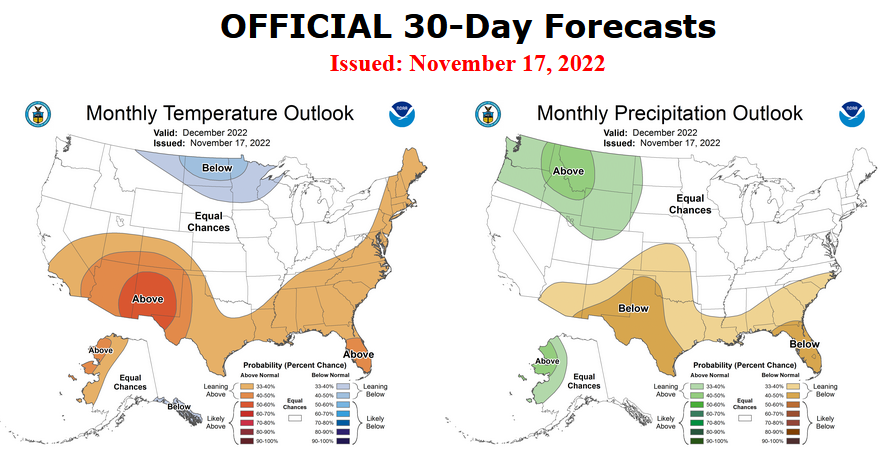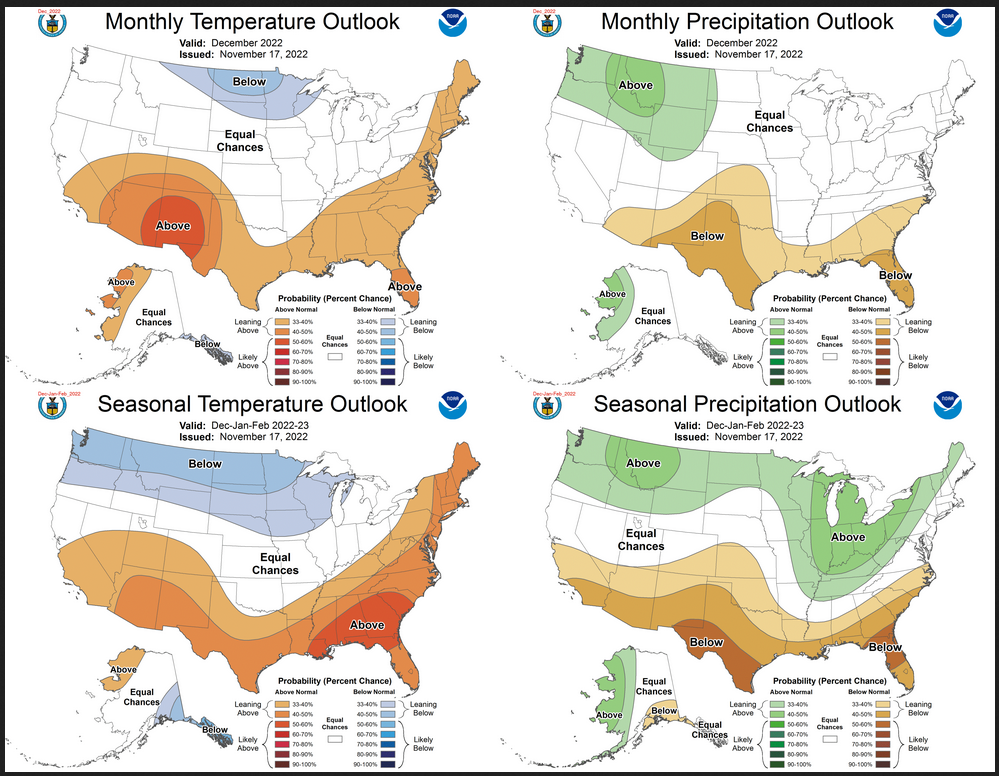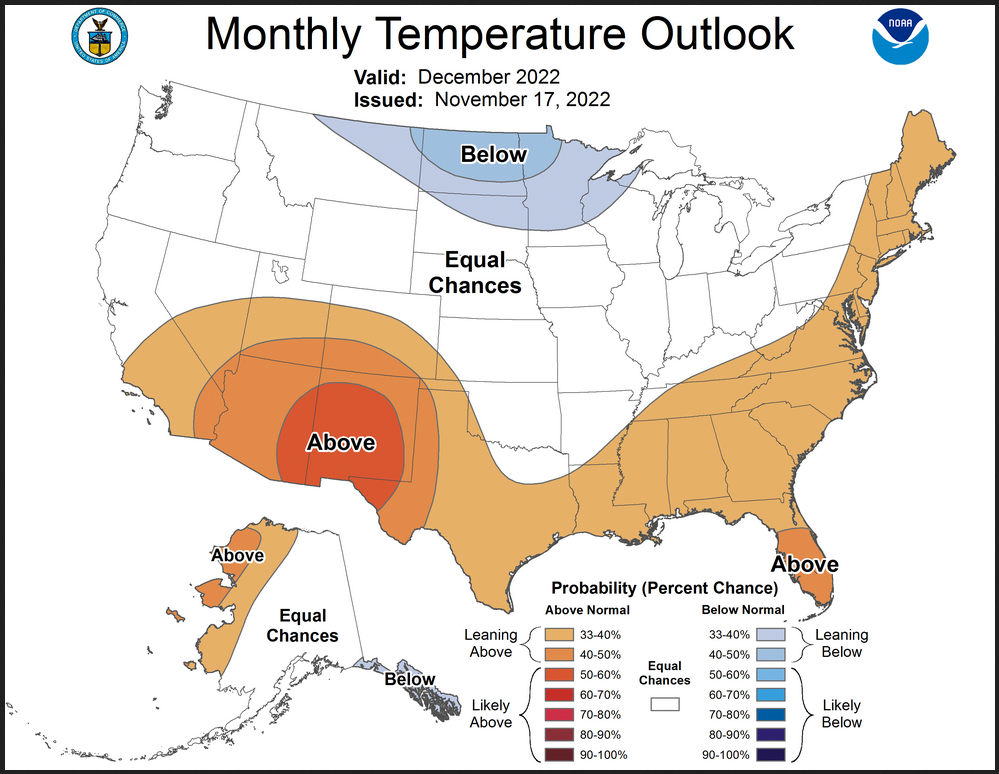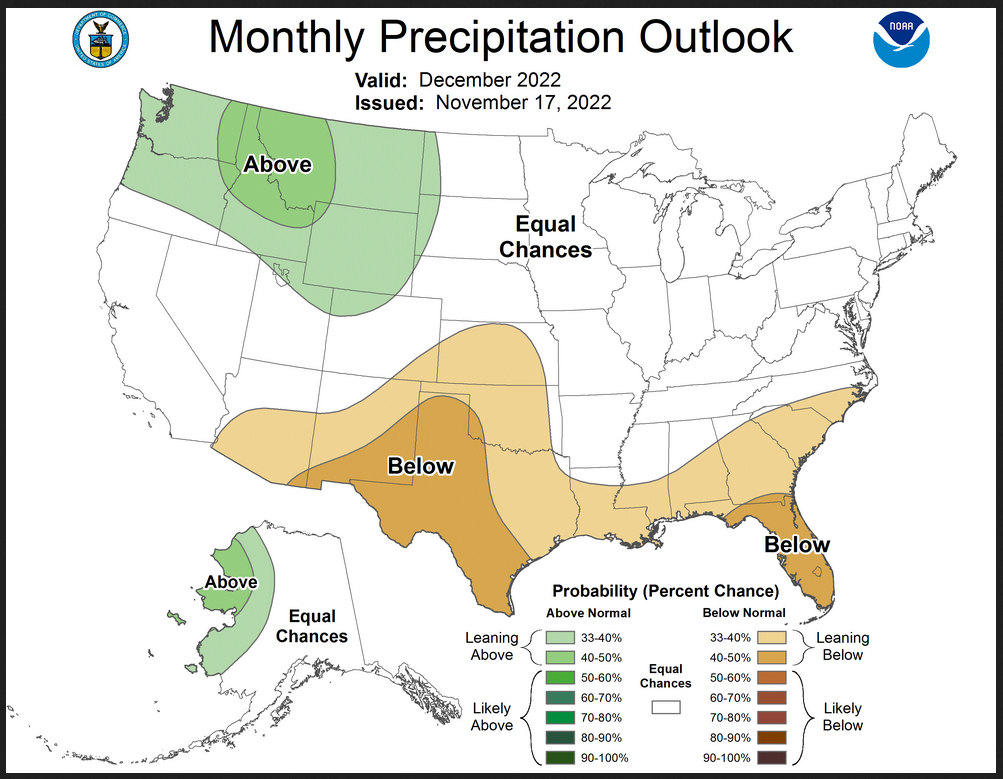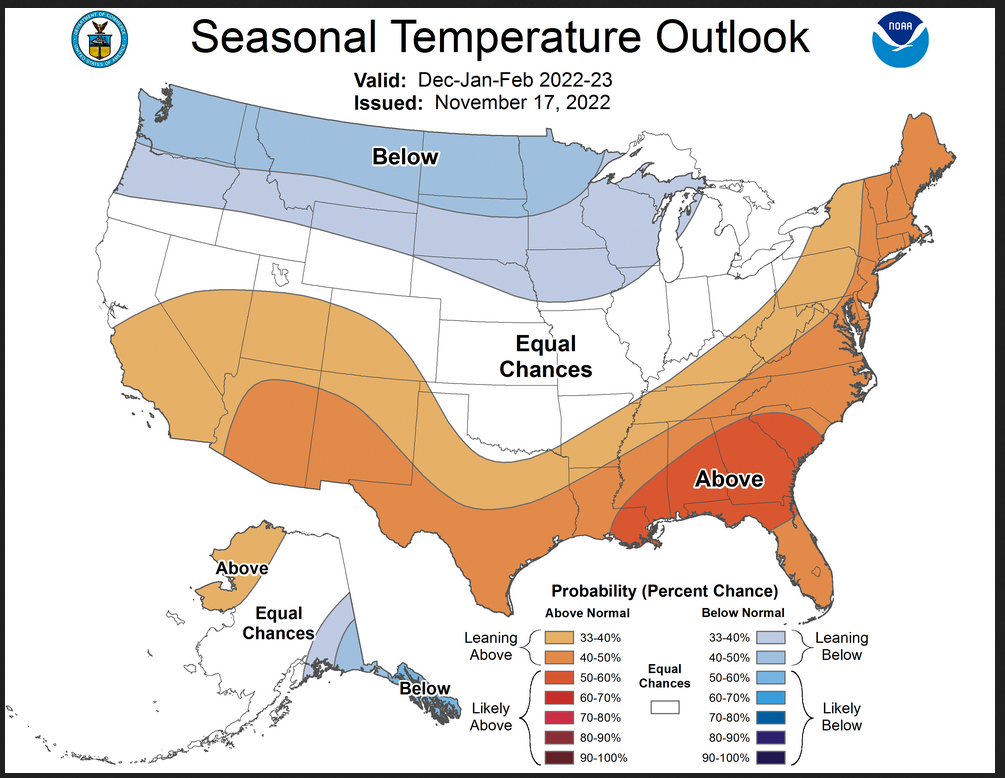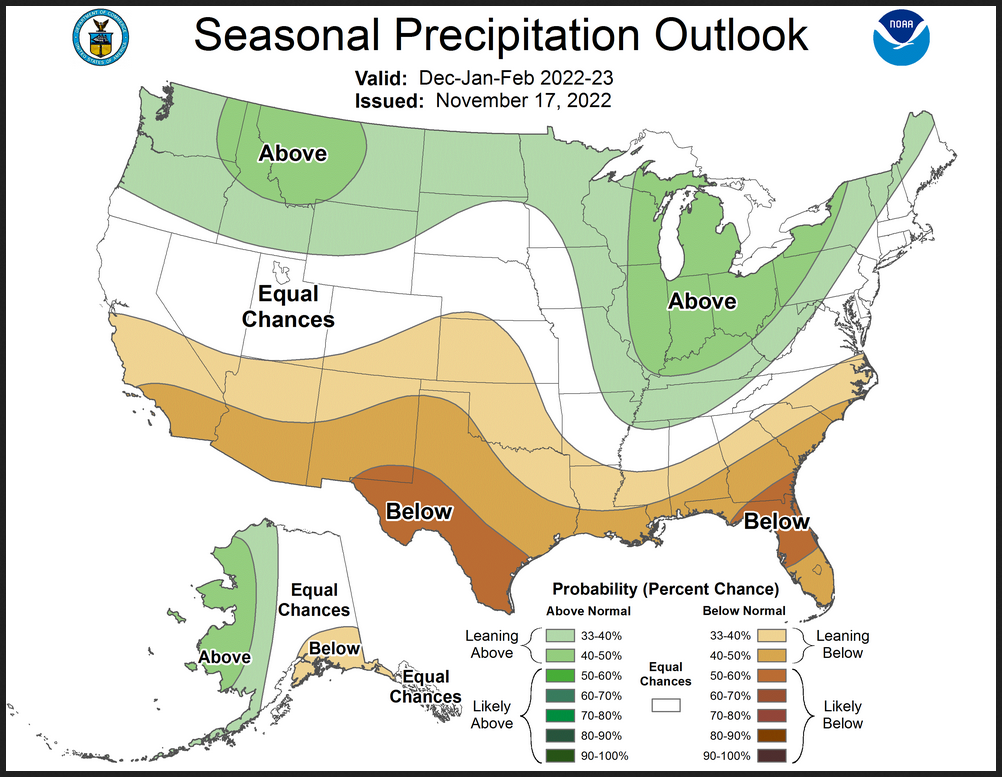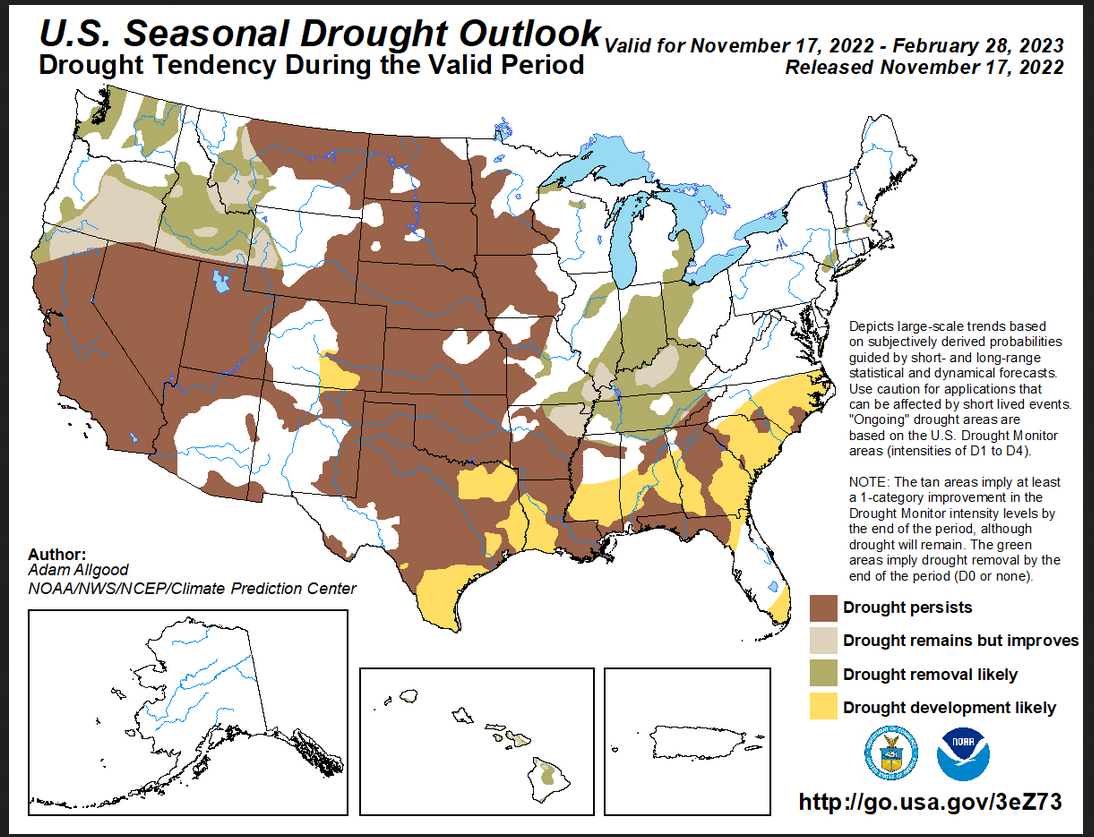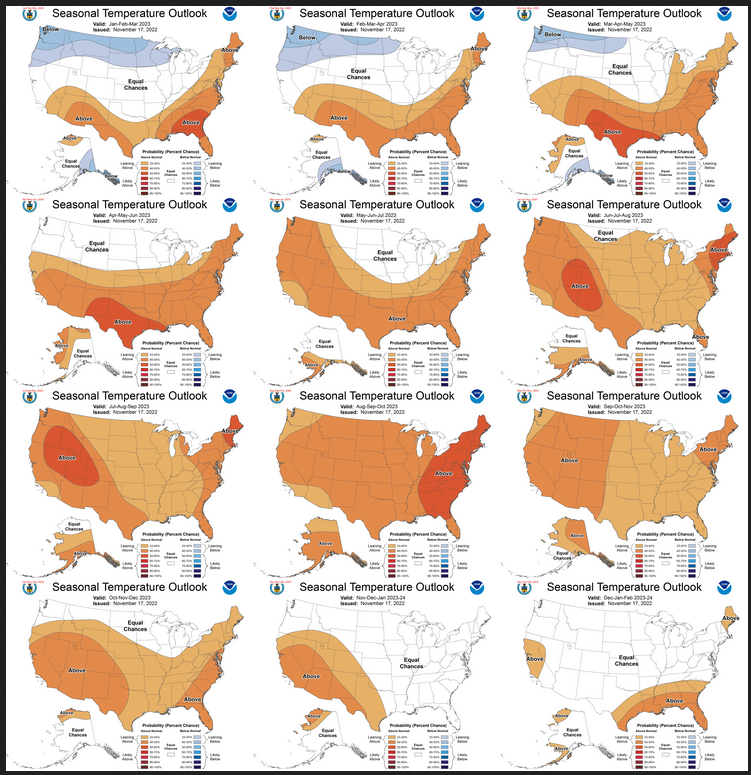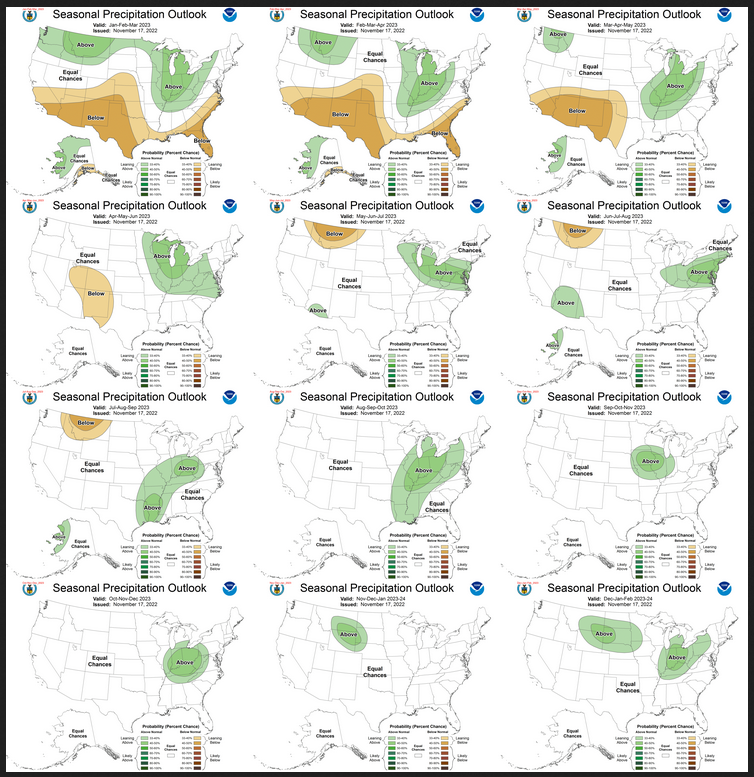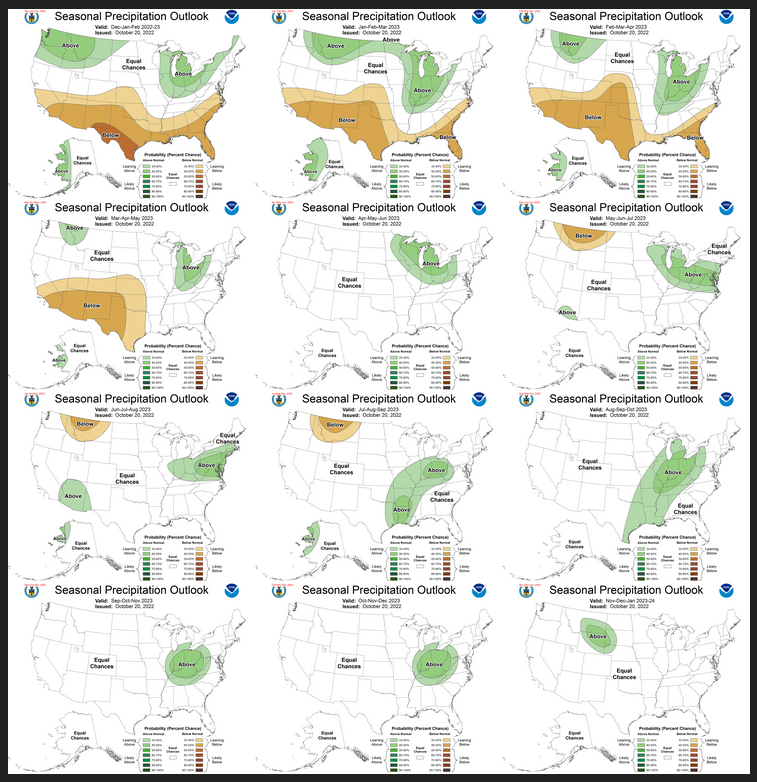La Nina Winter, then ENSO Neutral and Then Maybe Something Else
Today is the third Thursday of the month so right on schedule NOAA has issued what I describe as their Four-Season Outlook. The information released also includes the MId-Month Outlook for the single month of December plus the weather and drought outlook for the next three months. I present the information issued and try to add context to it. It is quite a challenge for NOAA to address the subsequent month, the subsequent three-month period as well as successive three-month periods for a year or a bit more.
We will begin to see the end of La Nina Impacts in March/April/May of 2023 and they will pretty much end before June/July/August of 2023, and there will be another change in November/December/January 2023/2024. Why that last change? Could it be an El Nino or ENSO Neutral with an El Nino Bias?
It is very useful to read the excellent discussion that NOAA issues with this Seasonal Outlook. NOAA seems to be more confident about making predictions beyond six months. They even predict a good Southwest Monsoon next summer which they never used to do this far in advance.

First, let’s Take a Look at the Mid-Month Outlook for December
Combination Mid-Month Outlook for December and the Three-Month Outlook
The top row is what is now so-called the Mid-Month Outlook for December which will be updated at the end of November. There is a temperature map and a precipitation map. The second row is a three-month outlook that includes December. I think the outlook maps are self-explanatory. What is important to remember is that they show deviations from the current definition of normal which is the period 1991 through 2020. So this is not a forecast of the absolute value of temperature or precipitation but the change from what is defined as normal or to use the technical term “climatology”.
| Notice that for precipitation, the December and three-month outlooks are quite similar except for the Northern Tier east of the Dakotas. So for those areas, the December/January outlook is very wet. It is somewhat the same situation for temperature but not for the Northwest. So for that area, the December/January outlook is very cool. |
| For both temperature and precipitation, if you assume the colors in the maps are assigned correctly, it is a simple algebra equation to solve the month two/three anomaly probability for a given location = (3XThree-Month Probability – Month One Probability)/2*. So you can derive the month two/three outlook this way. You can do that calculation easily for where you live or for the entire map. |
Here are larger versions of the Temperature and Precipitation outlook maps for the single month of December
The maps are pretty clear in terms of the outlook.
And here are large versions of the three-month DJF 2022-2023 Outlook
First temperature followed by precipitation.
The maps are larger versions of what was shown in the first graphic that had smaller versions of all four of these maps.
Drought Outlook
–
|
The yellow is the bad news and there is a lot of it. And this is a three-month outlook plus the remainder of November. Texas and to the east will have drought problems. The Northwest and Midwest improve. The Hawaiian Islands improve.
|
Short CPC Drought Discussion
Latest Seasonal Assessment – During the past month, persistently dry and warm conditions for this time of year resulted in an unusually widespread and rapid development of autumn drought conditions across the Plains, Midwest, and Southeast. As of November 1, abnormal dryness and drought conditions blanketed over 85 percent of the contiguous United States, which is the most on record since the inception of the U.S. Drought Monitor. During early November, a frontal system brought swaths of heavy precipitation to northeastern Texas, Arkansas, and the middle and upper Mississippi Valley, sparking some relief to these drought conditions, while a winter storm brought widespread snow and ice to the northern Plains. Further east, the remnants of Hurricane Nichole combined with a frontal boundary to bring generous recharging moisture to parts of the Northeast. Despite these areas of improvement, drought coverage remains extensive across the CONUS.
The forecast for the December 2022 through February 2023 (DJF) period is heavily influenced by the high potential for La Niña conditions to persist through a third Boreal winter season in a row. Climate anomalies associated with cold ENSO events are robust, and typically favor drier and warmer conditions along the southern tier of the CONUS, and wetter conditions for the Pacific Northwest, northern Rockies, and northern Plains due to a northward displaced mean storm track. Across the eastern US, a favored winter storm track tends to develop across the mid-South and Ohio River Valley through interior New England. Both the December monthly and DJF seasonal temperature and precipitation outlooks from the Climate Prediction Center strongly reflect these canonical La Niña climate anomalies. Therefore, a below-average peak wet season is anticipated for central to southern California and the Southwest, favoring drought persistence, while drought reductions are favored for the Northwest and northern Intermountain West. Little additional drought development is forecast for the Four Corners region due to lingering effects from a robust summer monsoon, though some development is favored for southeastern Colorado where initial conditions are considerably drier. Across the northern Plains and Midwest, dry climatology and freezing soils and streams limit the potential for drought improvements before the Spring thaw, while drought improvements are more likely across the Tennessee and Ohio River Valleys. Continued recharge with climatologically generous precipitation favors continued drought improvements for the Northeast, while dry, warm winter conditions across the southern tier favor widespread drought development across eastern Texas and the Southeast. Drought development is also possible across South Florida, while extremely wet conditions due to Hurricanes Ian and Nicole preclude winter drought development north of Lake Okeechobee.
La Niña winters tend to be wetter than normal across Hawaii; therefore, continued drought reductions are the most likely outcome. No drought is currently posted or expected to develop during the DJF period across Alaska and Puerto Rico.
Looking out Four Seasons.
Twelve Temperature Maps. These are overlapping three-month maps
Notice that this presentation starts with December/January/February 2022/2023 (DJF since NDJ is considered the near-term and is covered earlier in the presentation. The changes over time are generally discussed in the discussion but you can see the changes easier in the maps.
| I see three points in time where the pattern significantly changes and they are MAM 2023, JJA 2023 and NDJ 2023/2024 |
Comparing the new outlook with the prior Outlook,
The 12 temperature maps that were released last month.

I have been showing the current set of outlooks with the prior set side by side. But I think the images are too small for most to be able to work with. I do the analysis so you do not need to but if you choose to do so the best way is to print out both maps. If you have a color printer that is great but not needed. What I do is number the images from last month 1 – 12 starting with “1” and going left to right and then dropping down one row. Then for the new set of images, I number them 2 – 13. That is because one image from last month in the upper left is now discarded and a new image on the lower right is added. Once you get used to it, it is not difficult. In theory, the changes are discussed in the NOAA discussion but I usually find more changes. It is not necessarily important.
Now the Twelve Precipitation Maps
Similar to Temperature in terms of the organization of the twelve overlapping three-month outlooks.
| Similar to temperature, I see three major points in time where the pattern significantly changes and they are MAM 2023, JJA 2023 and NDJ 2023/2024. |
The maps that were released last month.
NOAA Discussion
Maps tell a story but to really understand what is going you need to read the discussion. I combine the 30-day discussion with the long-term discussion and rearrange it a bit and add a few additional titles (where they are not all caps the titles are my additions). Readers may also wish to take a look at the article we published last week on the NOAA ENSO forecast. That can be accessed here.
I will use bold type to highlight some things that are especially important. My comments, if any, are enclosed in brackets [ ].
CURRENT ATMOSPHERIC AND OCEANIC CONDITIONS
A La Niña advisory remains in effect and the tropical Pacific atmosphere is consistent with La Niña. Below average SST anomalies persisted across the equatorial Pacific and strengthened in the east-central tropical Pacific in the beginning of November. Recent observed SST anomalies in the NINO3.4 region reached -1.0 degrees Celsius. Subsurface temperature anomalies (averaged from 180-100W and 0-300 meters) decreased rapidly in mid-June 2022 from positive to negative and have remained negative. During the last two months, negative subsurface temperature anomalies persisted near the surface and at depth in the eastern and east-central Pacific, while positive subsurface temperature anomalies have mostly persisted, at depth, in the western and central Pacific Ocean. These cooler than average temperatures support continuation of La Niña conditions through winter 2022-2023, but chances gradually decrease with a 57% chance of transitioning to ENSO-neutral in FMA 2023.
A renewed Madden Julian Oscillation (MJO) signal is forecast for the upcoming few weeks and there is good agreement among dynamical models favoring a more coherent MJO continuing to propagate eastward to the western Pacific. However, forecasts of the progression of the MJO are uncertain and, if the MJO propagates eastward, we expect that MJO activity may only impact very early parts of DJF 2022-2023. Therefore, La Niña remains the primary driver of winter 2022-2023 temperature and precipitation outlooks.
SST anomalies along the northwestern coast of Alaska are warmer than normal, while SSTs in the Gulf of Alaska and along the west coast are below average, a shift from mostly warmer than average SST anomalies throughout October. Off the west coast of the U.S., SST anomalies are neutral, with a small region of below normal SST anomalies near southern California, and above normal SST anomalies near northern California. Following mixed positive and negative SST anomalies along the East Coast in October, SSTs are now warmer than average, particularly along the coast of New England.
PROGNOSTIC DISCUSSION OF SST FORECASTS
The CPC NINO3.4 consolidation forecast shows SST anomalies near -1.0 degrees Celsius in DJF 2022-2023, with the Constructed Analogue (CA) predicting SST anomalies less than -1.0 degrees Celsius and the North American Multi-Model Ensemble (NMME) slightly below -0.5 degrees Celsius. Tools agree on a transition to ENSO neutral in FMA 2023.
The International Research Institute for Climate and Society (IRI) / Climate Prediction Center (CPC) plume average of forecasts for the Niño-3.4 SST region from the last month depicts a 76% chance of La Niña during the Northern Hemisphere winter (December-February) 2022-23 and gradually decreasing odds of La Niña with a transition to ENSO-neutral favored in FMA 2023 (57% chance). ENSO neutral then becomes the most favored category and this continues through June-August (JJA) 2023.
PROGNOSTIC TOOLS USED FOR U.S. TEMPERATURE AND PRECIPITATION OUTLOOKS
Dynamical model forecasts from the NMME and Copernicus (C3S) multi-model ensemble systems are used for the first six leads when they are available as was the objective, historical skill weighted consolidation, that combines both dynamical and statistical forecast tools. Potential typical impacts known to be associated with La Niña winters are utilized in preparation of the outlook via common techniques that include composite analysis (including consecutive La Niña events) and regressions anchored to Niño 3.4 SST in both diagnostic and prognostic terms. La Niña impacts were considered through the FMA 2023 forecast lead consistent with the expected La Niña evolution. Statistical guidance such as the global SST based Constructed Analog (CA), experimental Calibration, Bridging, and Merging (CBaM) guidance, and long term temperature and precipitation trends played a role in many of the outlook seasons. Objective, historical skill-based consolidation tools contribute to the outlook and include the ENSO/OCN and the complete suite of statistical/dynamical tool combinations. Coastal SSTs also are considered, especially at the early leads.
30-DAY OUTLOOK DISCUSSION FOR DECEMBER 2022
The December 2022 temperature and precipitation outlooks are based on the Weeks 3-4 model solutions (valid for early to mid-December), dynamical model output for December, La Niña composites, consideration on the forecasted state of the Madden Julian Oscillation (MJO), and decadal trends . Below-average sea surface temperatures continue across the central and eastern equatorial Pacific, while suppressed convection was observed near and west of the Date Line this past month. The oceanic and atmospheric observations reflect La Niña conditions which are likely to persist through the winter.
Temperature
The MJO is forecast to strengthen and propagate eastward to the West Pacific during late November. Although the GEFS and ECMWF models are in good agreement on this MJO evolution, large ensemble spread exists on the strength of the MJO with many GFS ensemble members depicting a higher amplitude MJO event compared to the majority of ECMWF ensemble members. Lagged composites, based on phase 5 of the MJO RMM index, would favor below-normal temperatures overspreading the central and eastern contiguous U.S. (CONUS) during early to mid-December. Given the expected mild start to the month for most areas east of the Rockies, this would translate to a highly variable temperature pattern during December which lowers forecast confidence in the monthly temperature outlook for the central and eastern CONUS. Therefore, a large coverage of equal chances (EC) of below, near, or above-normal temperatures is necessary. Below-normal temperatures are favored for the northern Great Plains where the week 3-4 ECMWF model along with La Niña composites feature a cold signal. Above-normal temperatures are only slightly favored along the East Coast, consistent with the week 3-4 model solutions and the North American Multi-Model Ensemble (NMME). The dynamical model output along with La Niña composites support increased probabilities for above-normal temperatures throughout the southern tier of the CONUS. Although there is support for larger probabilities of above-normal temperatures across the Southeast, the GFS ensemble mean depicts a negative NAO heading into December which limits forecast confidence for this region. The highest forecast confidence in the temperature outlook exists across the Southwest where week 3-4 solutions along with dynamical and statistical tools are in good agreement.
Precipitation
La Niña composites for November-December-January (NDJ) are the major guidance relied upon for the December precipitation outlook along with the NMME. Above-normal precipitation is most likely across the Pacific Northwest, northern to central Rockies, and northern high Plains. Conversely, below-normal precipitation is favored for parts of the Southwest, central to southern Great Plains, Gulf Coast, and Southeast. Although statistical tools support a drier outcome for California, EC is forecast for the state due to a lack of support from monthly dynamical models and a robust wet signal evident in the week 3-4 ECMWF model solution. Also, the ensemble means are in good agreement on an amplified 500-hPa trough centered near the West Coast during the final week of November. EC is also forecast for the Great Lakes and Ohio Valley where the wet signal, associated with La Niña, typically occurs later in the winter season.
The dynamical and statistical tools are in good agreement and depict elevated probabilities for below (above)-normal temperatures for the Alaska Panhandle (western Mainland Alaska). Despite the NMME favoring above-normal temperatures across the Aleutians, EC was forecast for this region due to negative sea surface temperature anomalies nearby and a strong cold signal in the week 3-4 ECMWF model. The NMME and decadal trends support increased probabilities for above-normal precipitation for northwestern Alaska. Although La Niña typically favors dryness for the Alaska Panhandle during the winter, EC was forecast due to a weak signal among the dynamical model output.
SUMMARY OF THE OUTLOOK FOR NON-TECHNICAL USERS (Focus on December 2022 and January and February 2023)
Temperature
The December-January-February (DJF) 2022-2023 temperature outlook depicts elevated odds of below normal temperatures over the northern U.S., stretching from the Pacific Northwest to parts of the western Great Lakes. Below normal temperatures are also favored for the Alaska Panhandle and southeastern parts of Alaska. Above normal temperatures are more likely over the Southwestern U.S., stretching across the southern U.S. and into the Northeast. The highest probabilities for above normal temperatures are found over the Gulf Coast States. Over Alaska, above normal temperatures are most likely over the northwestern parts of the state.
Precipitation
The DJF 2022-2023 precipitation outlook favors above normal precipitation over the Pacific Northwest through parts of the Northern Plains, as well as over the Great Lakes and Ohio and Tennessee Valley regions. Elevated odds of below normal precipitation are favored over the southern third of the U.S., with the highest probabilities over parts of southeastern New Mexico and southern Texas, as well as parts of the Gulf Coast States. Over Alaska, a tilt toward above normal precipitation is favored over western Alaska, while enhanced probabilities of below normal precipitation are favored over parts of the South Coast.
Areas depicted in white and labeled “Equal-Chances” or “EC” are regions where climate signals are weak and so there are equal odds for either above-, near- or below-normal seasonal mean temperatures and total precipitation amounts.
Equatorial sea surface temperatures (SSTs) are below average across most of the Pacific Ocean and La Niña conditions are present. The La Niña state is expected to continue through DJF 2022-2023 (76% chance) followed by a transition to ENSO-neutral in February-April (FMA) 2023 (57% chance).
BASIS AND SUMMARY OF THE CURRENT LONG-LEAD OUTLOOKS
PROGNOSTIC DISCUSSION OF OUTLOOKS – DJF 2022 TO DJF 2023
TEMPERATURE
The DJF 2022-2023 temperature outlook favors above-normal temperatures for most of the southern half and the eastern third of the CONUS. The highest odds for above normal temperatures (50 to 60 percent) are over parts of the Gulf Coast States, consistent with agreement among dynamical and statistical tools, as well as expected impacts during La Niña and positive decadal temperature trends. Anomalously high SSTs and decadal trends , along with consistency in dynamical models, tilts odds towards above normal over the Northeast. Above normal temperature probabilities are weaker in DJF 2022-2023 and January-February-March (JFM) 2023 over southern California compared to the previous outlook given weaker signals in tools over the western U.S.
Elevated probabilities for below normal temperatures are forecast for the northern contiguous United States (CONUS) over the region stretching from the Pacific Northwest to the Great Lakes in DJF 2022-2023. Some NMME and C3S models favored warmer than normal or EC for parts of the northern CONUS, however, the forecasted below normal temperatures are consistent with La Niña impacts, below normal decadal trends in the north-central CONUS, and an anomalously positive snowpack. Over Alaska, the DJF 2022-2023 depicts enhanced probability of above normal temperatures over northwestern parts of the state, consistent with dynamical model forecasts, decadal trends , and anomalously warm SSTs. Below normal temperatures are favored over southeastern Alaska and the panhandle, given strong consistency among available tools. Though some tools, such as NMME, favored warming stretching to the southwestern coast of Alaska, EC is favored due to anomalously cold SSTs along the southeast coast.
The area of below normal probabilities along the northern CONUS and over southeastern Alaska is expected to persist through JFM 2023 consistent with the forecast La Niña, and coverage gradually decreases and probabilities weaken through March-April-May (MAM) 2023 as ENSO neutral becomes the favored state in the Tropical Pacific. Though ENSO neutral is forecast with a 57% probability in FMA 2023, CFSv2 forecasts of SST anomalies remain weakly cold through at least MAM 2023, and we expect some lingering persistence of the atmosphere related to La Niña. Similarly, above normal temperature probabilities over the southern and eastern CONUS and northwestern Alaska are maintained, though expand spatially over CONUS, through MAM 2023. Above normal temperature probabilities are prevalent over CONUS beginning in April-May-June (AMJ) 2023 and expand through September-October-November (SON) 2023, given dynamical and statistical tools that agree on enhanced above normal probabilities, as well as ENSO/OCN and other consolidation forecast tools for which long term temperature trends contribute significantly at times in various regions beyond lead 6. Over Alaska, the tilt toward above normal temperatures over northwestern Alaska shifts southward in May-June-July (MJJ) 2023 following dynamical models , and above normal probabilities expand across the state by August-September-October (ASO) 2023 before decreasing spatially through the end of the forecast period (DJF 2023-2024), consistent with statistical forecast tools.
PRECIPITATION
The DJF 2022-2023 precipitation outlook depicts increased probabilities for above-normal seasonal precipitation over the west coast of Alaska, the Pacific Northwest, northern Rockies, and portions of the Great Lakes, and Ohio and Tennessee Valley regions. Enhanced probabilities of above-normal precipitation in the Pacific Northwest are largely based on composite analysis of La Niña winters, as are enhanced precipitation over the Great Lakes and Ohio/Tennessee Valley, however, elevated chance of Lake Effect snow over the Great Lakes also adds to enhanced above normal probabilities over the Great Lakes. NMME, CFSv2, and decadal trends support a slight tilt toward above normal probabilities over parts of North Dakota and Minnesota, which is expected to persist through JFM 2023.
Drier than normal conditions are most likely for south-central Alaska and along the southern tier of the CONUS in DJF 2022-2023, also consistent with expected La Niña impacts in DJF. The highest probability of below-normal precipitation (50%) is depicted over parts of the Southwest and Texas, as well as parts of Georgia and Florida, consistent with dynamical model guidance favoring enhanced probability of below-normal precipitation in these regions, and enhanced probabilities of above normal temperatures over the Gulf Coast States. Though NMME and C3S were slightly drier this month over the state of California, EC is favored over northern parts of the state due to comparatively low hindcast skill over Northern California as well as tendency toward storminess over northern California in winter months.
Similarly to the temperature outlooks, probabilities remain strong through JFM 2023 given the La Niña forecast, and are forecast to persist through MAM 2023 though the areas of favored above normal precipitation decrease spatially as Tropical Pacific SSTs transition to neutral. The favored area of below normal precipitation remains steady across the southern tier of the U.S. through FMA 2023 before decreasing to the Southwest in MAM 2023. This is consistent with dynamical model and statistical tools through MAM 2023, as well as expected La Niña impacts through the winter and transition seasons. Uncertainty increases in AMJ 2023 through the end of the forecast period, particularly as we rely more heavily on ENSO/OCN and other statistical consolidation forecast tools based on trends beginning in MJJ 2023. As such, larger areas of EC are forecast over the CONUS. This remaining set of outlooks are primarily based on the forecast consolidation of statistical guidance and long term precipitation trends and remain similar to the forecasts issued in October.
This paper may be of interest.
Review of the ENSO Assumptions utilized by NOAA (CPC) in Preparing this Four-Season Outlook
It is useful to review the ENSO forecasts used by NOAA to produce this Four-Season Outlook. We reported on that last week and you can read that article by clicking HERE
The key information used by NOAA follows.
IRI CPC ENSO STATE Probability Distribution (IRI stands for the International Research Institute for Climate and Society)
Here are the new forecast probabilities. This information is released twice a month and the first release is based on a survey of Meteorologists, the second is based on model results. The probabilities are for three-month periods e.g. SON stands for September/October/November. I am just showing the first release which is what we have and presumably what NOAA (actually their CPC Division) worked from.

| Notice for JFM 2023 the probability of La Nina exceeds the probability for ENSO Neutral. But for FMA the probability for ENSO Neutral slightly exceeds that for La Nina. So maybe March is when the ocean conditions will be consistent with ENSO Neutral but the impact on our weather may lag a month or so. So we really seem to be looking a La Nina into Spring. This is a very slight change from the analysis made last month. NOAA refers to a difference between the dynamic models and the statistical models which show the transition to be slightly later and NOAA leans towards the statistical models as per their discussion. |
Tropical Subsurface Temperature Anomalies
| You can update this graphic by clicking HERE |
–
| The image will update if you click HERE. https://www.cpc.ncep.noaa.gov/products/people/wwang/cfsv2fcst/images3/nino34SeaadjPDFSPRDC.gif
NOAA used to rely more on the IRI Forecast but now that CPC seems to have taken more control over IRI it is not totally clear how they determine their ENSO forecast. But it is pretty much evident in the NOAA Discussion and the set of 12 three-month maps they provide and which are shown in this article. I assume it takes them a couple of days to produce their Seasonal Outlook so it is always difficult to know the exact date of the data they utilized. |
Resources
The link for the drought outlook map and some discussions that come with the map can be found by clicking HERE.
| I hope you found this article useful and interesting. |
